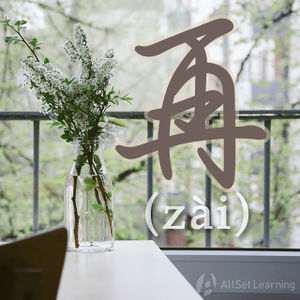Difference between revisions of "Expressing "again" in the future with "zai""
| Line 9: | Line 9: | ||
<div class="jiegou"> | <div class="jiegou"> | ||
| − | Subj. + 再 + Verb | + | Subj. + 再 + Verb Phrase |
</div> | </div> | ||
| Line 17: | Line 17: | ||
<div class="liju"> | <div class="liju"> | ||
| − | * <em>再</em> | + | *我 明天 <em>再</em> 来。<span class="pinyin">Wǒ míngtiān <em>zài</em> lái.</span><span class="trans">I'll come again tomorrow.</span> |
| − | * | + | *请 <em>再</em> 说 一 遍。<span class="pinyin">Qǐng <em>zài</em> shuō yī biàn.</span><span class="trans">Say it again, please.</span> |
| − | * 我 | + | *我 想 <em>再</em> 看 一 遍。<span class="pinyin">Wǒ xiǎng <em>zài</em> kàn yībiàn.</span><span class="trans">I want to watch it again.</span> |
| − | * | + | *<em>再</em> 试 一下 吧。<span class="pinyin">Nǐ <em>zài</em> shì yīxià ba.</span><span class="trans">Try it again.</span> |
| − | * 你 | + | *你 可以 帮 我 <em>再</em> 问 一 下 吗?<span class="pinyin">Nǐ kěyǐ bāng wǒ <em>zài</em> wèn yīxià ma?</span><span class="trans">Can you ask for me one more time?</span> |
</div> | </div> | ||
Revision as of 09:21, 22 November 2016
-
Level
-
Similar to
- Expressing "again" in the past with "you" (B1)
- Expressing "the other" with "lingwai" (B1)
- Sequencing with "xian" and "zai" (B1)
- Comparing "zai" and "you" (B2)
- Expressing "never again" with "zai ye bu" (B2)
- Expressing "over and over again" with "zaisan" (B2)
- Expressing a last chance with "zaibu... jiu..." (B2)
- Expressing "even so" with "zaibu... ye..." (C1)
-
Used for
-
Keywords
While 又 (yòu) is used for "again" in the past, 再 (zài) is used for "again" in the future. That is, 再 is used when something has happened once and it will happen again.
Contents
再 as "again"
The basic structure for using the future "again" is:
Subj. + 再 + Verb Phrase
Some examples:
- 我 明天 再 来。I'll come again tomorrow.
- 请 再 说 一 遍。Say it again, please.
- 我 想 再 看 一 遍。I want to watch it again.
- 再 试 一下 吧。Try it again.
- 你 可以 帮 我 再 问 一 下 吗?Can you ask for me one more time?
In fact, this structure is present in one of the most common Chinese phrases: "再见!" In this case, it literally means "See you again!"
再 as "and then"
A usage that feels sort of related but deserves separate mention is the use of 再 to mean "and then." It is often preceded by 先 when giving clear sequential orders ("first do this... then do this..."), but it can also appear by itself to mean "and then."
The examples:
- 我们 先 吃饭 再 谈。We'll eat first, and then we'll talk.
- 你 先 找 工作 再 考虑 买 房子。First find a job, then you can think about buying a house.
- 我们 先 吃 了 饭 再 去。We ate first, then we went.
再 as "another" or "some more"
The English word "another" is often avoided altogether by using 再.
Examples:
- 你 再 给 我 一 张 纸。Give me another piece of paper.
- 我们 再 找 一 个 人 吧。Let's find another person.
- 她 想 再 做 一 个 新 的 作品。She wants to do a new kind of work.
- 我们 再等 他 五 分钟 吧 。Let's wait for him five more minutes.
- 你 再 给 我 一点 钱。Give me a little more money.
- 我们 再 给 她 点 时间 。We'll give her a little more time.
- 她 想 再 吃 点 冰淇淋 。She wants to eat a little more ice cream.
再 as "continuous action"
Here 再 is similar to the English "for a while longer" or "keep [going/doing]".
Examples:
- 时间 还 早,你们 再 玩 一会儿 吧。It's still early, you can keep playing for a while.
- 再 找 找,找 不 到 我们 就 回去。Look a little more. If we can't find it, we'll go home.
- 我 想 再 睡 会儿,太 困 了。I want to sleep a little longer. I'm so tired.
See also
Sources and further reading
Books
- Integrated Chinese: Level 2, Part 1 (pp. 157) →buy
- New Practical Chinese Reader 3 (新实用汉语课本3) (pp. 202) →buy
Websites
- Yale Chinese Usage Dictionary: Using 再 and 又



